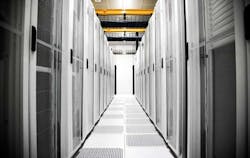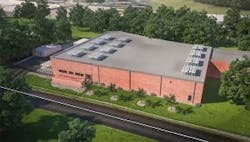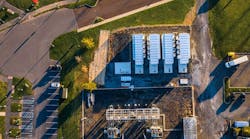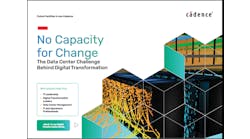For a growing ecosystem of startups, investors and analysts, edge computing is the hot new frontier. But it’s old hat for EdgeConneX.
That’s why EdgeConneX would like to “retake ownership of the edge,” according to Phillip Marangella, the Chief Marketing Officer at EdgeConneX, which has been focused on edge deployments since its founding in early 2010.
“I see a lot of buzz in the market around edge,” said Marangella. “We’re a bit forgotten in that we’ve been doing it for seven or eight years now. We want to remind folks of who we are and what we’ve done. It’s well established in the market. What we’re doing is real, and we’ve got real revenue and real customers.”
If EdgeConneX is no longer pigeonholed as an edge specialist, it’s because the company is one of the industry’s most versatile players, continuously expanding into new lines of business. In its early days, EdgeConneX helped cable companies extend their networks to cell towers and office buildings.
Then came Netflix and its “over the top” Internet video traffic, which stressed the networks of cable operators and telecoms. The solution was a national network of edge data centers that could cache video content locally, easing the traffic burden on network operators. EdgeConneX built 24 data centers in about 18 months, extending large-scale content distribution to second-tier markets across the U.S. and Europe. The company’s data centers are designed as “lights out” unmanned facilities, using sophisticated monitoring and remote hands for maintenance.
For its third act, EdgeConneX began working with hyperscale providers in 2016, building huge data center campuses in Amsterdam, Dublin and Chicago.
“We believe we have credibility at any size and form factor,” said Marangella. “It’s a spectrum of 20 kilowatts to 20 megawatts, and everything in between.”
A History of Living on the Edge
Edge computing will have a transformational impact on American society and business, enabling new technologies and services across instant wireless connectivity. As we’ve previously noted, edge computing is not a single technology, but a phrase that describes several layers of infrastructure, some of which are refinements of existing models. Edge infrastructure is a response to new technologies – such as autonomous vehicles, the Internet of Things, 5G wireless and distributed AI applications – that require low latency and close proximity to users. These technologies are shaping the future of Internet infrastructure.
“We believe we have credibility at any size and form factor. It’s a spectrum of 20 kilowatts to 20 megawatts, and everything in between.”
Phillip Marangella, EdgeConneX
But for EdgeConneX, the current enthusiasm for edge feels like a case of “Back to the Future,” especially the discussion of densifying data infrastructure at telecom towers. The company was founded in 2010 by Chief Operating Officer Edmund Wilson as an extension of his work with fiber providers and tower owners.
“We don’t talk much about it, but towers are where we got started,” said Marangella. “We built enclosures at towers to handle backhaul. That’s what spawned going bigger. We wanted more multi-tenancy and aggregation.”
The edge market has evolved to focus on new technologies, but Marangella says EdgeConneX capabilities remain relevant with next-generation workloads.
“The methodology is all the same, and we’ve done it all,” he said. “Where the ultra-low latency stuff comes into play, customers like what we can do.”
Building Fast, Across Many Markets
As we noted in 2016, The EdgeConneX design is perhaps the most ambitious example yet of using automation to streamline operations and alter data center economics.
The key to this approach is an advanced design and operations template that allows EdgeConneX to rapidly retrofit existing buildings into data centers with Tier III redundancy that can support high-density workloads of more than 20kW per cabinet (and with some customers, up to 50kW). This allowed the company to deploy 18 new data centers in 2014. Each facility was a 2 to 4 megawatt data center with about 10,000 square feet, with an anchor tenant that was usually a cable multi-system operator (MSO) like Comcast or Liberty Global, which are both investors in EdgeConneX.
EdgeConneX uses a patented data center operating system called EdgeOS to monitor and manage its facilities. There are more than 500,000 sensors used in the company’s data centers, monitored every 15 milliseconds. Facilities are managed from a central network operations center in Santa Clara, with remote hands support when on-site maintenance is required. The company has the ability to remotely control the generators and UPS systems at each data center.
A new EdgeConneX data center near Atlanta. (Image: EdgeConneX)
Many regional EdgeConneX data center sites are in expansion mode, with new facilities being built in Atlanta, Toronto, Miami, Denver, Portland and Phoenix. The new data centers are slightly larger than the first round of facilities, reflecting the growth of business demand. The user base has also expanded, with more managed service providers joining the network operators.
“Once we got gravity in those markets, we began building larger data centers,” said Marangella. “We’re starting to see hybrid cloud builders be interested in cloud on-ramps in those markets. We’re bringing the multi-hybrid cloud closer to you.”
Building for the Cloud
The company’s rapid deployments in 2014 and 2015 got the attention of cloud computing platforms, who were looking to deploy new capacity faster. EdgeConneX began working with one of the hyperscale players on several large projects in Europe, starting in Amsterdam.
“We built what could arguable considered the largest data center in the Netherlands in terms of megawatts,” said Marangella. “We did it in Dublin and Chicago, and it’s not just one provider. We’re almost an extension of their own capabilities.”
The Dublin project featured a new wrinkle: on-site power generation. The local utility grid was constrained in Grange Castle, a business park about 20 miles west of London, so EdgeConneX built a natural gas power facility to supplement the grid.
Is hyperscale the new business model? Marangella says EdgeConneX isn’t constrained by project type.
“People have noticed that we’re working on hyperscale projects, and say ‘are you now ScaleConneX?'” he said. “Our model isn’t limited to Tier 2 markets and a few megawatts. Edge can be 20 to 30 megawatts.”
Staying Focused on Customers
As it surveys the opportunities at the cloud and the edge, Marangella says EdgeConneX will do what it has always done: listen closely to customers. The company doesn’t build speculative projects, which is one reason it has been somewhat low-key in the midst of all the headlines about edge computing.
“Our model has always been about our customers and giving them what they want,” he said.
But Marangella said EdgeConneX expects to play a key role in creating new infrastructure for the New Edge.
“It’s still early days, to be honest,” he said. “The amount of traffic traversing the network is astronomical. There’s no end in sight. The volume and velocity of these traffic flows are mandating a rearchitecting of the Internet.
“If you’re making it faster and cheaper for the enterprise to consume IT services, everyone wins,” Marangella added. “This is where you’re going to see the cloud get more distributed. We’re an enabler of this. We can solve those problems, in any market and any form factor.”







